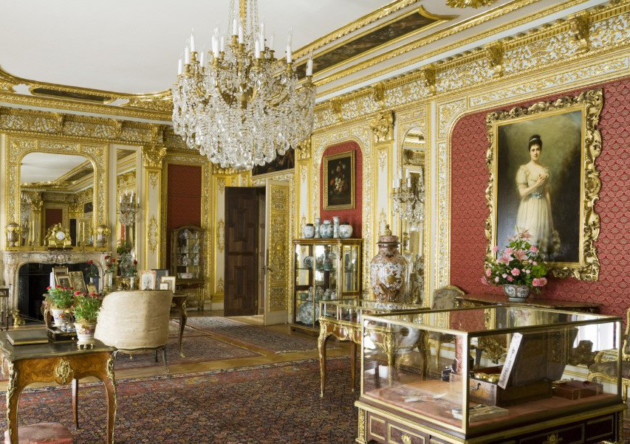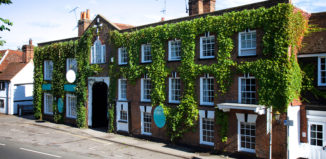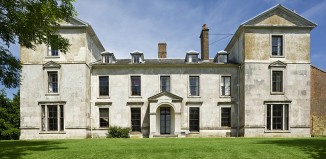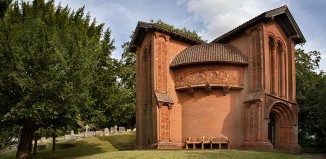Polesden Lacey

Polesden Lacey, an exquisite Edwardian house in the heart of Surrey, continues to amaze visitors, just as its extravagant former owner, Mrs Margaret Greville, intended. Known as one of the greatest hostesses of the Edwardian era, Mrs Greville bought Polesden with her husband, Ronald, in 1906 and employed the architects of the Ritz Hotel, Mewès and Davis, as well as the interior decorating firm of White, Allom & Co to transform the original 19th-century property into the perfect house for entertaining. Their efforts were put to the greatest effect in the Saloon, where the sense of luxury abounds over every square inch, from the glinting chandelier suspended above the Persian carpets to the golden carved panelling along the walls salvaged from an Italian palazzo. Mrs Greville announced that she wanted a room fit to entertain Maharajahs and that is exactly what she got.
Today, visitors to the Saloon will also be able to view display cases filled with treasured items that Mrs Greville collected, including Fabergé, Cartier and Meisssen pieces, many of which were gifts from visiting royalty and other influential figures.
“Margaret travelled a lot for a woman of her time and always made a beeline for the most famous or influential people wherever she went and they would often come to visit her at Polesden as well,” says Vicky Nutt, House and Collections Manager. “She collected people like others might collect stamps, and the Royal family were at the pinnacle of her collection. King George VI and the Queen Mother spent their honeymoon here and Margaret and the Queen Mother became great friends.”
Mrs Greville’s visitors book, now located on the first floor landing, reads like a who’s who of the period, with the signatures of Winston Churchill, Charlie Chaplin and Edward VII (among others) scrawled across its pages.
It wasn’t just rich and powerful friends that Mrs Greville collected; Polesden is packed with fine art and ceramics in almost every room. “The collections at Polesden rival any museum or art gallery, but I always think it’s how close you can get to everything here that makes it so special,” says Nutt.
The picture corridor, which runs around three sides of the central courtyard, is lined with paintings by Dutch masters, such as Pieter de Hooch and Gerard TerBorch, as well as impressive oriental urns and a Roman sarcophagus dating from 3AD.
The Central Hall, where Margaret would have greeted her guests on arrival, is draped with Flemish tapestries dating from the 16th century alongside intricately carved woodwork around the fireplace. The woodwork was a reredos from Christopher Wren’s St Matthew’s church that White, Allom & Co acquired at auction after the church was demolished.
Margaret’s favourite artworks were originally hung at her other property in London but were brought to Polesden after her death. It was her London property where she lived and spent most of her time, while Polesden was essentially used as Mrs Greville’s ‘party house’ and was specially kitted out with all mod cons to accommodate her guests. Of the property’s 18 bedrooms, 15 were en suite, which would have been unheard of at the time. Polesden was also one of the first properties to have electricity installed and there is even a lift which links Margaret’s ground floor study to her bedroom suite on the first floor.
This life of luxury was made possible due to Margaret inheriting her father’s fortune.
“Mrs Greville didn’t have the best start in life. She was the illegitimate daughter of a brewer and a boarding house steward, although her parents did eventually marry when Margaret was in her early 20s.” explains Nutt. “They made a huge amount of money from beer which Margaret then inherited; she always said she would rather be a beeress than a peeress!”
Mrs Greville was generous with her wealth. As well as putting on lavish gatherings for her eminent guests, she also held a servants’ ball in the Central Hall every Christmas where up to 100 people, including suppliers and tradesmen, were invited. The ball would have been a household highlight at Polesden, where the staff would dust off their best outfits and Mrs Greville would make an appearance, dazzling the assembled servants in all her finery, including ropes of pearls and a diamond tiara. These jewels were later bequeathed to the Queen Mother and now form part of the Royal Collection. Margaret’s personal Christmas parties on the other hand were a more intimate affair with between 12 and 20 people attending for dinner.
Despite all the jollity enjoyed at Polesden, Margaret’s life wasn’t always one big party. In 1908 her husband, the Hon. Ronald Greville, died from pneumonia after an emergency operation for throat cancer. Although the couple were married for 17 years they never had any children, so after Margaret’s death in 1942 she left Polesden Lacey to the National Trust. “It was going to be left to George VI but he inherited the throne instead!” says Nutt.
On her death, Margaret also left her car to her chauffer and various amounts of money to her servants depending on how long they had worked for her. Her butler alone received £500, which was no small sum at the time.
In the absence of Mrs Greville, Polesden’s party atmosphere has been kept alive by its current custodians and visitors to this National Trust property can expect to find a pianist playing in the Saloon, people joining in with games in the Billiard Room, and the Dining Room table set as it was for Edward VII’s visit in 1909. All of this can be found amid the excited chatter of visitors wandering from room to room where the professional comedians Mrs Greville employed for after-dinner entertainment have been replaced by volunteers telling anecdotes about Margaret and her life.







